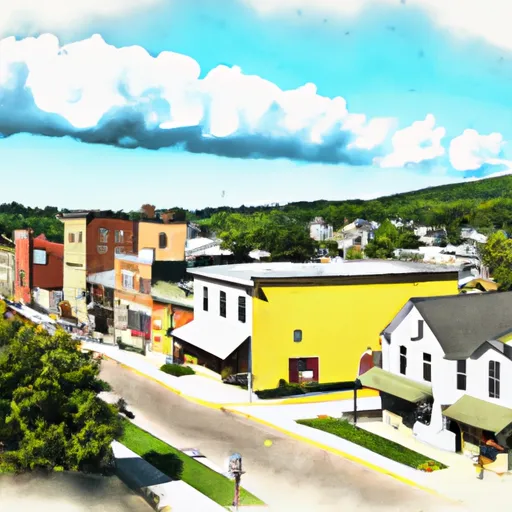-
 Snoflo Premium
Snoflo Premium
Get unlimited access to all our content
With no Ad interruptions! - Start Your Free Trial Login with existing account
Mc-Kees-Rocks
Eden Index
Climate
8.3
•
Recreation
2.8
•
Community
3.5
•
Safeguard
5.2/10

McKees Rocks, Pennsylvania is a small borough located northwest of Pittsburgh. The climate in McKees Rocks is characterized as a humid continental climate, with cold winters and warm summers. Average temperatures range from around 30°F (-1°C) in winter to 80°F (27°C) in summer, with moderate rainfall throughout the year.
The borough is surrounded by water, with the Ohio River flowing along its western border. The hydrology constituents in McKees Rocks mainly revolve around the Ohio River, offering boating, fishing, and water sports opportunities. The river provides a scenic backdrop for outdoor activities and attracts nature enthusiasts.
In addition to water-based activities, McKees Rocks offers various outdoor recreational opportunities. The borough is home to several parks and green spaces, including McKees Rocks Community Park and Sto-Rox Neighborhood Park. These parks provide walking trails, picnic areas, sports fields, and playgrounds for residents and visitors to enjoy.
Overall, McKees Rocks, Pennsylvania, offers a moderate climate suitable for outdoor activities throughout the year, with the Ohio River and local parks providing ample opportunities for recreation and relaxation.
What is the Eden Index?
The Snoflo Eden Index serves as a comprehensive rating system for regions, evaluating their desirability through a holistic assessment of climate health, outdoor recreation opportunities, and natural disaster risk, acknowledging the profound impact of these factors on livability and well-being.
Climate Health Indicator (CHI): 8.3
Mc-Kees-Rocks receives approximately
947mm of rain per year,
with humidity levels near 81%
and air temperatures averaging around
12°C.
Mc-Kees-Rocks has a plant hardyness factor of
6, meaning
plants and agriculture in this region thrive during a short period during spring and early summer. Most
plants will die off during the colder winter months.
By considering the ideal temperature range, reliable water supplies, clean air, and stable seasonal rain or snowpacks, the Climate Health Indicator (CHI) underscores the significance of a healthy climate as the foundation for quality living.
A healthy climate is paramount for ensuring a high quality of life and livability in a region, fostering both physical well-being and environmental harmony. This can be characterized by ideal temperatures, reliable access to water supplies, clean air, and consistent seasonal rain or snowpacks.
Weather Forecast
Streamflow Conditions
Upper Ohio-Beaver
Area Rivers
Upper Ohio-Beaver
Snowpack Depths
Upper Ohio-Beaver
Reservoir Storage Capacity
Upper Ohio-Beaver
Groundwater Levels
Recreational Opportunity Index (ROI): 2.8
The Recreational Opportunity Index (ROI) recognizes the value of outdoor recreational options, such as parks, hiking trails, camping sites, and fishing spots, while acknowledging that climate plays a pivotal role in ensuring the comfort and consistency of these experiences.
Access to outdoor recreational opportunities, encompassing activities such as parks, hiking, camping, and fishing, is crucial for overall well-being, and the climate plays a pivotal role in enabling and enhancing these experiences, ensuring that individuals can engage in nature-based activities comfortably and consistently.
Camping Areas
| Campground | Campsites | Reservations | Toilets | Showers | Elevation |
|---|---|---|---|---|---|
| Mason - Dixon Historical Park | None | 1,170 ft | |||
| Colonel Crawford County Park | 111 | 1,308 ft | |||
| Tygart Lake State Park | None | 1,516 ft |
Nearby Ski Areas
Catastrophe Safeguard Index (CSI):
The Catastrophe Safeguard Index (CSI) recognizes that natural disaster risk, encompassing floods, fires, hurricanes, and tornadoes, can drastically affect safety and the overall appeal of an area.
The level of natural disaster risk in a region significantly affects safety and the overall livability, with climate change amplifying these risks by potentially increasing the frequency and intensity of events like floods, fires, hurricanes, and tornadoes, thereby posing substantial challenges to community resilience and well-being.
Community Resilience Indicator (CRI): 3.5
The Community Resilience Indicator (CRI) recognizes that education, healthcare, and socioeconomics are crucial to the well-being of a region. The CRI acknowledges the profound impact of these elements on residents' overall quality of life. By evaluating educational resources, healthcare accessibility, and economic inclusivity, the index captures the essential aspects that contribute to a thriving community, fostering resident satisfaction, equity, and social cohesion.

